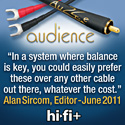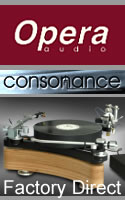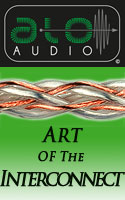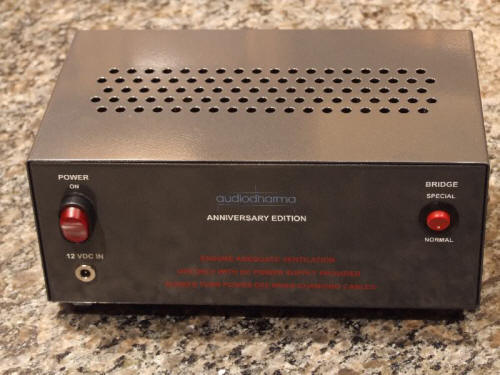|
|
You are reading the older HTML site
Positive Feedback
ISSUE
58
audio excellence audiodharma Anniversary Edition Cable Cooker as reviewed by Jim Merod
Voodoo or its Close Approximation Alan Kafton's remarkable Anniversary Edition audiodharma Cable Cooker offers a crazy good, thoroughly useful (uncomplicated) way to add sonic value to mediocre audio cables and to enhance even the most expensive, cryonic-treated over-the-top (price no object) wire. I owe a doff of my Boston Red Sox Apology Cap to Alan because I intended to crank out this first of two reports on his superlative audio wire cooking unit awhile back. Better late than never, as Sophocles was thought to believe when, in his ninth decade, he married a twenty year old woman who took him right into the grave at age ninety. I'll let you discern ironies contingent to that crafty old Oedipus-inventing scribbler's priapic ancient youth. Here today, late, no longer poised for never's absent now, I push ahead with more reserve than the grand optimistic Dramatist Extraordinaire (contemporary of Plato and Aristotle and the Peloponnesian War... a splendid era, indeed, return to that future with trepidation). I'll leave technical—and implementation—details for my second report. In the meantime I'll point to an ear-opening experience I had late last spring when I recorded a world class jazz quintet in my usual multi-track format (with a pre-panned, direct to two track sub-mix alongside) and, in addition, for what astute "on location" recording engineers call a Back Up Safety Recording for Shits and Giggles. Despite the arcane technicality of that rubric's designation. I'll assume the idea is patently clear. First of all, live recording people can never be redundant enough. I'll expand on this theme soon in an essay that dwells precisely with the topic "what can deviate always does so maddeningly beyond retrieval"... but I regress (I do!). On this occasion, my normal multi-track recording came out as I expected. No problems, sonic values precisely as I set them—or, to be more accurate, as I reached for them in the semi-dark of "on location" recording's mostly blind leap of hope plus faith in search of good luck and the absence of sonic gremlins. What startled me about the night's results was the "safety" recording's awe-inspiring clarity and vividness. I had employed a single pair of two-plus meter balanced Stealth Indra cables, cooked on Maestro Kafton's unit, taking signal feeds from a matched set of large-bore tube microphones directly into a one-bit DSD two track recorder. Believe me, I'm well aware that such a recording unit can, under many circumstances, smoke a more conventional 24/96 hi-rez recording device for inherent reasons of clarity achieved by the one-bit domain. One bit recordings are by and large more transparent than higher bit-rate audio capture. But, against the greater dynamic impact and complex transient precision of multi-miked pick up over simple two mike ambient capture, the outcome in sonic and musical seduction in favor of the simpler signal path was both startling and, to a surprising degree, counter-intuitive. Note that I'm taking into consideration an innate difference in resolution that favors the one-bit (two mike) regime at the outset. And yet, hearing such comparisons over several years with these precise cables in place, at no moment before this had I encountered the truly jaw-dropping difference in favor of the simple ambient recording that resulted when this pair of genuinely state-of-the-art cables were cooked (warmly prepared for delectation) by the Audio Excellence magic box—otherwise designated (aka) the "electrically massage-your-wire and seduce your heart and ears sunshine unit"—that Maestro Kafton has sprung upon a still somewhat unsuspecting (or simply not yet familiar) audio universe. This Cable Cooker Gizmo Thing Works! Consider this: I discovered that an immensely expensive pair of Indra cables, which I'm very familiar with from dozens of recording and play back uses, already "elite" and distinctive in their pristine clarity (just a touch on the analytic side), became a more profoundly clear, distinct and "elite" audio signal transfer partner under the revivified influence of Alan Kafton's welcome demonic trickery. It must be trickery because how else can a state of the art anything outdo itself by nearly an order of magnitude with such a seemingly simple but no doubt devilishly covert set of hidden maneuvers? The whole thing is a little like Dark Energy or maybe Dark Matter: one decreasing the tug of gravity on the cosmos, the other increasing gravity's influence. So which is it here: acceleration or deceleration? Is this Kafton guy setting himself up for a Nobel Award down the road, this cable cooking stuff merely the opening act of something more insidious or maybe uniquely benign and contributive to humanity's infinite enlightened confusion beyond the mere joy of audio enhancement? No Tricks Here When I report a mega-increase in audio seduction achieved by a stellar set of cables now re-empowered mysteriously by this cooking routine, I mean to indicate first and most that the cooked Indras delivered a live sonic sound stage to an extremely high resolution digital recording device as close to the absolute analog warmth, relaxation and truthful transient decay as any recording (digital or analog) I've ever made. The concept of "sonic seduction" that I invoke here is doubtless the most laudatory phrase I can offer to define (and praise) raw recorded music, whether that occurs in a studio or "on location." The conjunction of tonal warmth and musical relaxation in the presence of persuasively immediate transient clarity identifies the essential sonic qualities of superior analog recordings. The cable cooking unit increased all that, converting the inevitable slight "lack" of a strong digital recording to the seductive welcome of a strong analog recording. There it is. It does not get better than that in one swoop of essentially easily dismissed (overly subtle) set up adjustment, change or intervention.
The subtlety of the whole process is truly Zen-like. Connect the cables as designated. Burn or cook for (say) 44 hours. Disconnect. Put 'em where you want 'em. Bingo, bang-bang. A new sonic universe in one effortless step with one nearly invisible motion. Zen, indeed ! I'll now look for a way to achieve Zen banking. The revival of vinyl in many audiophile home systems is not an accident of nostalgia or longing for superior album art. Analog sound is more real, more accurate to the instantaneous proximity of the ear to live music. There is a glory to a single trumpet note articulated by Chocolate Armenteros that no one could possibly deny if heard with the man himself in front of you. I've witnessed such a note and its accompanying phrases building triumphant sonic glory. The beauty of that too little known man's playing, the remarkable nobility of his articulation and embouchure, literally fill your heart and soul. In the world of digital sound, one hears the approximation of that nobility and its musical (visceral) victory. But, in the presence of the great man, himself, you feel the hair on the back of your neck rise to salute a sound like no other in musical history... alluring, beguiling and (yes) seductive. My point is that, while in many ways we're stuck with (and surrounded by) digital sound replication, any relatively fanatical music-loving person should plunge into live music as often as time and resources allow. My ambition as a live recording "engineer" is, simply, to come as close as possible to the actual sound of music in real space and time—in specific sonic spaces with inevitably unique acoustic signatures. For me, the eccentricities of decent recording spaces create part of (perhaps the unrivaled foundation of) the sonic attraction that engages me each night, in each venue, where I record. At the recent Monterey Jazz Festival, I talked with the longtime site manager of the Blue Note jazz club in New York where I've enjoyed wonderful evenings with Herbie Hancock, Joe Henderson, John Hicks, Craig Handy and too many others to list. My recording experience in that venerable setting has always been hard work because, first, the stage creaks mercilessly and, worse, the acoustical "footprint" of the room is not merely "odd" but genuinely deleterious to anything approaching sonic beauty. All the more, therefore, my respect for the amazing George Shearing trio recordings made there by Telarc. Trust me here: even though I know how those sessions were captured, it's one thing to know that and another (altogether) to do it! In distinct contrast, I love Birdland's present iteration in New York's garment district. In my judgment, there's not a more attractive and enjoyable "jazz room" that I'm aware of. Its classic, first and most legendary, romantic location was on 52nd Street, near the Three Deuces. Birdland then moved uptown to the southern edge of Harlem. It was a restaurant with jazz more than a jazz club with decent food. Nonetheless, a lot of great playing went down there. I recorded the inimitable Jimmy Madison on drums with Ray Drummond on bass and John Hicks (piano) one night when possibly twelve people came in on a January night that dropped snow from seven in the early evening night until two in the morning... a scattering of snow dust that grew into a foot and a half accumulation. No cabs were running after midnight's deep snow made driving perilous. My dear friend, the great acoustic guitarist Gene Bertoncini—who knew I was recording there with a gaggle of gear and no obvious way to get myself and my load up to Benny Golson's studio where I was living that week—drove his orange BMW 2002 up to Birdland (unasked!) and saved me from a night's miserable "sleep" on the uncarpeted club floor. Fifteen years later, in 2006, I did in fact sleep on Birdland's floor (carpeted) at its current location in the garment district. I spent the night, with owner John Valenti's permission and support, scoping out each cubic meter of the great jazz mecca's acoustics since my assignment the next night (a Sunday) was to make the first and only recording of the legendary Chico O'Farrill's Afro-Cuban Big Band. The challenge was not merely to get the sonic pick up right—or, literally, perfect, in my estimation—but to rectify such long archival neglect. Even though that Grammy Award-winning aggregation played every Sunday night at Birdland's three locations since the band was formed in 1944 by Chico O'Farrill and Dizzy Gillespie, no recording on location had been attempted. The hours alone all night to scope out the club's odd angles, acoustic bumps and comb filtering were investments in an amazing recording. Some prayers are answered. You'd've wanted to be there. This digression is intended to articulate my deep understanding of the unequaled virtues of "live" sound and music... experiential virtues under assault or erasure to a genuinely lamentable degree because of the nearly mindless ease by which music can be pumped into a room, a venue or directly into your head via ubiquitous digital signal transfer (with or without cables). Unless one plunks his rear in a club, hall or auditorium seat to hear what real music sounds like in its utmost sonic and musical reality, the genuine experience fades in the twilight of replicated approximations. Life is short, Herman... give your ears and heart a boost with the erotic joy of physically-intimidating music! On the Road to a Distant Zen Temple Alan Kafton "is" Audio Excellence and his mysteriously successful Anniversary Edition Cable Cooker resides, in a universe of necessary audio cables employed for the lusty work and joyful play of audio recording and musical playback, precisely in the life-enhancing spot that food occupies in sustaining our organic being. Great cables are a glorious self-indulgence for those who can afford them. But, for the ninety-plus per cent of music lovers whose budgets suffer real world limitations, who am I to neglect reminding you that a truly state-of-the-art cable such as Serguei Timachev's Stealth Indras reach beyond their normal over-achieving sonic splendor after this unit's massaging. And modestly priced but value-giving cables, like Len Miller's new Gen II Soundstring wires, become newly and thoroughly enhanced to a level of musical seduction that no person in his right mind would previously think possible... before the impossible became routine with Kafton's Magic Mystery Box. If it had wings I'd wonder if it could fly. In the meantime, you should know that, if you've invested several grand or more in a sound system that you like even as you yearn for better results, you owe it to yourself—and the alluring surplus achievable here: tactile analog sonic duende—to check this unit out. I'm not completely sure what "anniversary" this box celebrates, but it may very well be the inauguration of cheer your private musical world will generate across Balvenie—or Olde Number 7—elevated evenings for years to come. Jim Merod
Anniversary Edition Cable Cooker
Audio
Excellence AZ
|







.jpg)